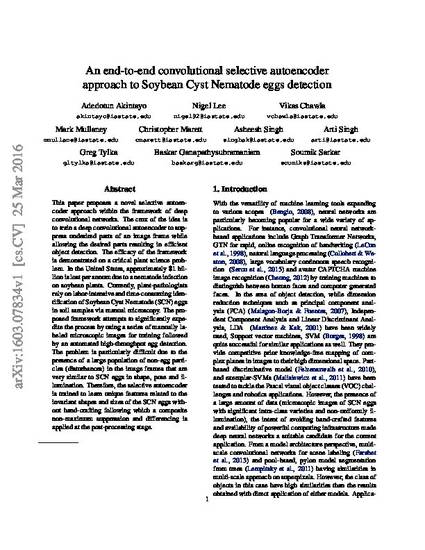
Presentation
An end-to-end convolutional selective autoencoder approach to Soybean Cyst Nematode eggs detection
Mechanical Engineering Conference Presentations, Papers, and Proceedings
Document Type
Conference Proceeding
Disciplines
Conference
22nd ACM SIGKDD Conference on Knowledge Discovery and Data Mining
Publication Version
Accepted Manuscript
Link to Published Version
http://dx.doi.org/10.1145/1235
Publication Date
1-1-2016
DOI
10.1145/1235
Conference Title
KDD 2016 Workshop on Data Science for Food, Energy and Water
Conference Date
August 13-17, 2016
Geolocation
(37.7749295, -122.41941550000001)
Abstract
Soybean cyst nematodes (SCNs), Heterodera glycines, are unwanted micro-organisms that reduce yields of a major source of food–soybeans. In the United States alone, approximately $1 billion is lost per annum due to cyst nematode infections on soybean plants. Experts have conceived methods of mitigating the losses through phenotyping techniques via SCN eggs density estimation, and then applying the right control measures. Currently, they rely on labor intensive and time-consuming identification of SCN eggs in soil samples processed onto microscopic frames. However, phenotyping a vast array of fields requires automated high-throughput techniques. From an automation perspective, detection of rarely occurring SCN eggs in a microscopic image frame with a cluttered background of soil debris poses a major technical challenge. We propose a convolutional autoencoder approach that is armed with a novel selectivity criterion where we train a deep convolutional autoencoder to mask undesired parts in an image frame while allowing the desired objects. Our selective autoencoder is trained with expert-labeled microscopic images to learn unique features related to the invariant shapes and sizes of SCN eggs without any hand-crafting. The outcome is an efficient rare object detection framework which aids in automated high-throughput detection of the SCN eggs. The proposed framework reduces SCN eggs density estimation cost and expedites the overall phenotyping process significantly.
Copyright Owner
ACM
Copyright Date
2016
Language
en
File Format
application/pdf
Citation Information
Adedotun Akintayo, Nigel Lee, Vikas Chawla, Mark P. Mullaney, et al.. "An end-to-end convolutional selective autoencoder approach to Soybean Cyst Nematode eggs detection" San Francisco, CA(2016) Available at: http://works.bepress.com/baskar-ganapathysubramanian/53/

This is a manuscript of a proceeding from A. Akintayo, N. Lee, V. Chawla, M. Mullaney, C. Marett, A. Singh, A. Singh, G. Tylka, B. Ganapathysubramanian, S. Sarkar, “An end-to-end convolutional selective autoencoder approach to Soybean Cyst Nematode eggs detection”, Workshop on Data Science for Food Energy and Water at the 22nd ACM conference on Knowledge Discovery and Data Mining (KDD), San Francisco, Aug 2016. DOI:10.1145/1235. Posted with permission.